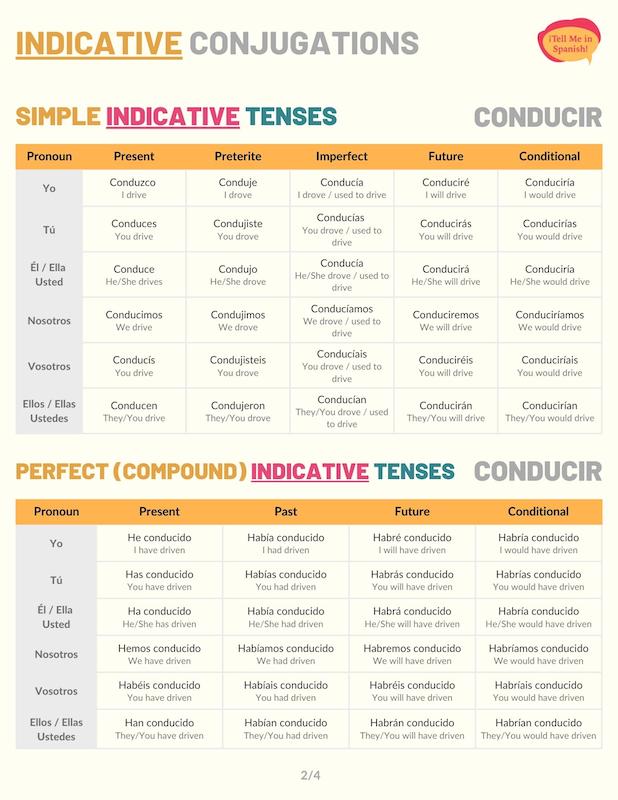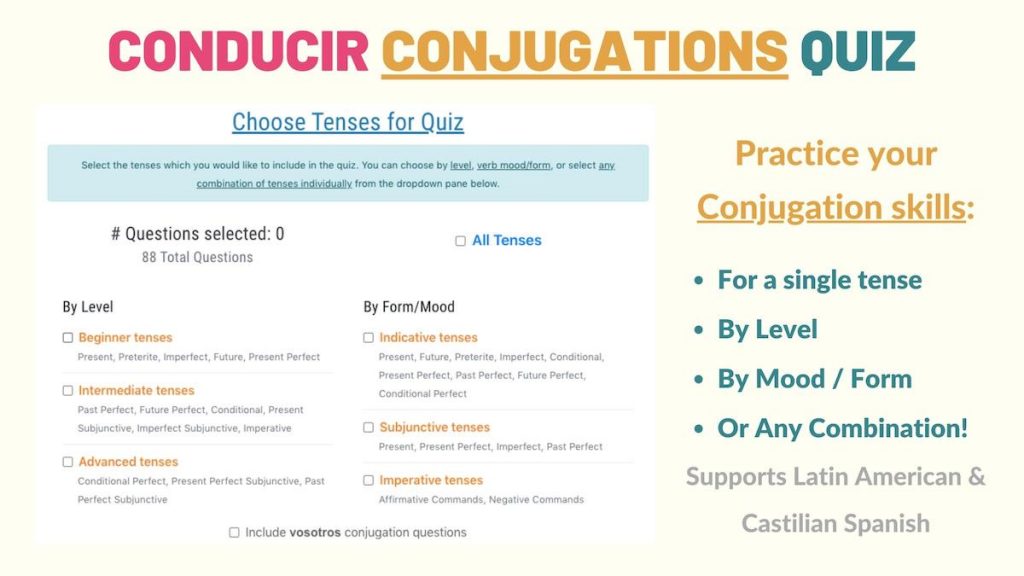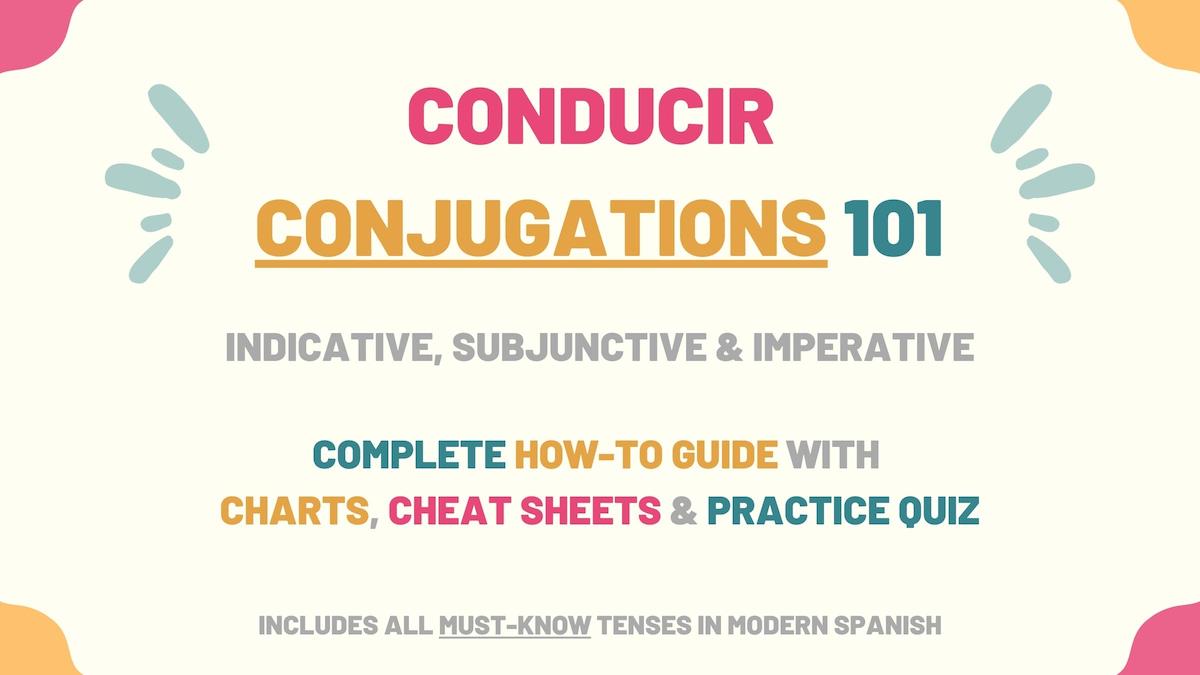In Spanish, conducir is an irregular -IR verb in some tenses. Since this is also a verb we use in daily situations, in this guide, we’ll go over the conducir conjugation pattern. Here is a summary of what you’ll learn:
- Conducir Overview
- Indicative Tenses of Conducir Conjugations
- Subjunctive Tenses of Conducir Conjugations
- Imperative (Commands) of Conducir Conjugations
- Uses & Examples
- Download Conducir Conjugation Tables & Uses Cheat sheets
- Conducir Conjugation Practice Quiz
Overview of Conducir
| Verb Characteristic | Property |
|---|---|
| Verb Type | -IR |
| Irregular | Yes |
| Infinitive | Conducir |
| Gerund (Present Participle) Form | Conduciendo |
| Past Participle Form | Conducido |
| Synonyms | Manejar, guiar, llevar, dirigir |
Irregularities:
- Present: conduzc only for ‘yo’.
- Preterite: conduj for all subject pronouns.
- Present Subjunctive: conduzc for all subject pronouns.
- Imperfect Subjunctive: conduje for all subject pronouns.
- Affirmative Imperative: conduzc only for ‘usted’ and ‘ustedes’.
- Negative Imperative: conduzc for all subject pronouns.
In Spanish, conducir means ‘to drive’, ‘to carry’, ‘to manage’, among other applications. The conjugation charts below only have one translation to keep the tables as concise as possible. You can learn more about the meanings of ‘conducir’ in the section Uses & Meanings.
Indicative Conjugations of Conducir
Present tense
Conducir present conjugation has one irregularity and it’s for the person ‘yo’. In other words, with this pronoun, we must use the stem conduzc. In the present tense, conducir is used to talk about people driving or current driving skills.
For example: Sandra conduce muy bien.
| Person | Conjugation | Translation |
|---|---|---|
| Yo | Conduzco | I drive |
| Tú | Conduces | You drive |
| Él / Ella Usted | Conduce | He/She drives You (formal) drive |
| Nosotros | Conducimos | We drive |
| Vosotros | Conducís | You drive |
| Ellos / Ellas Ustedes | Conducen | They drive You (plural) drive |
Take Note: As you may have noticed, the irregular ending zco is also applied to the verb conocer. Yo conozco, yo conduzco.
Preterite tense
Conducir preterite conjugations are formed with the irregular stem conduj. Since we’re using an irregular root, the preterite endings will not be accented. Conjugate conducir to the preterite tense to explain that someone drove at a specific moment in the past.
For example: ¿Quién condujo mi carro?
| Person | Conjugation | Translation |
|---|---|---|
| Yo | Conduje | I drove |
| Tú | Condujiste | You drove |
| Él / Ella Usted | Condujo | He/She drove You (formal) drove |
| Nosotros | Condujimos | We drove |
| Vosotros | Condujisteis | You drove |
| Ellos / Ellas Ustedes | Condujeron | They drove You (plural) drove |
Imperfect tense
The imperfect tense conjugations of conducir are regular. When using these conjugations, we’re describing how people used to drive repeatedly in the past. For example: Siempre conducíamos en la mañana.
| Person | Conjugation | Translation |
|---|---|---|
| Yo | Conducía | I drove I used to drive |
| Tú | Conducías | You drove You used to drive |
| Él / Ella Usted | Conducía | He/She drove He/She used to drive You (formal) drove You (formal) used to drive |
| Nosotros | Conducíamos | We drove We used to drive |
| Vosotros | Conducíais | You drove You used to drive |
| Ellos / Ellas Ustedes | Conducían | They drove They used to drive You (plural) drove You (plural) used to drive |
Near future
To form the Spanish immediate future, we must use the formula ir (present tense) + a + infinitive (in this case, ‘conducir’). These forms of ‘conducir’ are used to express that a person is going to drive soon in the future. Luis va a conducir esta noche.
| Person | Conjugation | Translation |
|---|---|---|
| Yo | Voy a conducir | I’m going to drive |
| Tú | Vas a conducir | You’re going to drive |
| Él / Ella Usted | Va a conducir | He/She is going to drive You (formal) are going to drive |
| Nosotros | Vamos a conducir | We’re going to drive |
| Vosotros | Vais a conducir | You’re going to drive |
| Ellos / Ellas Ustedes | Van a conducir | They’re going to drive You (plural) are going to drive |
Future simple tense
Conjugate conducir to the Spanish simple future to convey that someone will drive at some point in the future. For instance: No conducirás hasta que tengas tu licencia.
| Person | Conjugation | Translation |
|---|---|---|
| Yo | Conduciré | I will drive |
| Tú | Conducirás | You will drive |
| Él / Ella Usted | Conducirá | He/She will drive You (formal) will drive |
| Nosotros | Conduciremos | We will drive |
| Vosotros | Conduciréis | You (formal) will drive |
| Ellos / Ellas Ustedes | Conducirán | They will drive You (plural) will drive |
Conditional tense
As shown in the conjugation chart below, conducir is a regular verb in the Spanish conditional tense. In this tense, ‘conducir’ conveys that people would drive if a condition was met. You can also use these forms to wonder or make hypotheses regarding people’s driving.
For example: Si practicaras un poco más, conducirías muy bien.
| Person | Conjugation | Translation |
|---|---|---|
| Yo | Conduciría | I would drive |
| Tú | Conducirías | You would drive |
| Él / Ella Usted | Conduciría | He/She would drive You (formal) would drive |
| Nosotros | Conduciríamos | We would drive |
| Vosotros | Conduciríais | You would drive |
| Ellos / Ellas Ustedes | Conducirían | They would drive You (plural) would drive |
Present perfect tense
Haber in the present tense + conducido (past participle) is how you conjugate the Spanish present perfect. These conducir conjugations express that people have or haven’t driven. For example: ¿Quién ha conducido el coche de Luis?
| Person | Conjugation | Translation |
|---|---|---|
| Yo | He conducido | I have driven |
| Tú | Has conducido | You have driven |
| Él / Ella Usted | Ha conducido | He/She has driven You (formal) have driven |
| Nosotros | Hemos conducido | We have driven |
| Vosotros | Habéis conducido | You have driven |
| Ellos / Ellas Ustedes | Han conducido | They have driven You (plural) have driven |
Past perfect
The Spanish past perfect indicative tense is formed with haber (imperfect form) + past participle form of ‘conducir’. When conjugated to this tense, this verb is used to explain that someone had driven before another past action or past time frame. Ya habíamos conducido este carro.
| Person | Conjugation | Translation |
|---|---|---|
| Yo | Había conducido | I had driven |
| Tú | Habías conducido | You had driven |
| Él / Ella Usted | Había conducido | He/She had driven You (formal) had driven |
| Nosotros | Habíamos conducido | We had driven |
| Vosotros | Habíais conducido | You had driven |
| Ellos / Ellas Ustedes | Habían conducido | They had driven You (plural) had driven |
Future perfect
The Spanish future perfect of conducir expresses that someone will have driven by or before a specific future time frame or, simply, that a person might have driven. Here is a sentence: ¿Quién habrá conducido mi coche?
| Person | Conjugation | Translation |
|---|---|---|
| Yo | Habré conducido | I will have driven |
| Tú | Habrás conducido | You will have driven |
| Él / Ella Usted | Habrá conducido | He/She will have driven You (formal) will have driven |
| Nosotros | Habremos conducido | We will have driven |
| Vosotros | Habréis conducido | You will have driven |
| Ellos / Ellas Ustedes | Habrán conducido | They will have driven You (plural) will have driven |
Conditional perfect
If conjugated to the conditional perfect tense, conducir communicates that someone would have driven as long as a past condition had been met. For instance: Si hubieras traído tu licencia, ¿sí habrías conducido?
| Person | Conjugation | Translation |
|---|---|---|
| Yo | Habría conducido | I would have driven |
| Tú | Habrías conducido | You would have driven |
| Él / Ella Usted | Habría conducido | He/She would have driven You (formal) would have driven |
| Nosotros | Habríamos conducido | We would have driven |
| Vosotros | Habríais conducido | You would have driven |
| Ellos / Ellas Ustedes | Habrían conducido | They would have driven You (plural) would have driven |
Progressive tenses
Estar conjugated + conduciendo (present participle) is the formula to form the Spanish progressive tenses. We use these forms to express that someone is driving at the moment of speaking. Or, in the case of past tenses (preterite and imperfect), to say that a past action was in progress when someone was driving.
For example: Ayer estuve conduciendo todo el día.
| Progressive Tense | Formula | Translation Example |
|---|---|---|
| Present | Estar (present) + conduciendo | I am driving |
| Preterite | Estar (preterite) + conduciendo | You were driving |
| Imperfect | Estar (imperfect) + conduciendo | He was driving |
| Future | Estar (future) + conduciendo | We will be driving |
| Conditional | Estar (conditional) + conduciendo | They would be driving |
Conducir Subjunctive Conjugations
The Spanish subjunctive mood is used to discuss wishes, requests, suggestions, expectations, doubts, or hypothetical situations. In the sections below, you’ll find conducir conjugation charts for the most common subjunctive tenses.
Present subjunctive
Conducir subjunctive conjugations are also irregular. To form this tense, use the stem conduzc for all subject pronouns. When using these subjunctive conjugations, this verb can be used to make suggestions or express expectations about someone’s driving.
For example: No quiero que conduzcas en la noche.
| Person | Conjugation | Translation |
|---|---|---|
| Yo | Conduzca | I drive |
| Tú | Conduzcas | You drive |
| Él / Ella Usted | Conduzca | He/She drives You (formal) drive |
| Nosotros | Conduzcamos | We drive |
| Vosotros | Conduzcáis | You drive |
| Ellos / Ellas Ustedes | Conduzcan | They drive You (plural) drive |
Present perfect subjunctive
Haber in the present subjunctive + conducido is how you form the present perfect subjunctive form of ‘conducir’. With this tense, this verb is used to wonder or wish that a person has already driven. These forms can also express doubt. For instance: No creo que Julián haya conducido hoy.
| Person | Conjugation | Translation |
|---|---|---|
| Yo | Haya conducido | I have driven |
| Tú | Hayas conducido | You have driven |
| Él / Ella Usted | Haya conducido | He/She has driven You (formal) have driven |
| Nosotros | Hayamos conducido | We have driven |
| Vosotros | Hayáis conducido | You have driven |
| Ellos / Ellas Ustedes | Hayan conducido | They have driven You (plural) have driven |
Imperfect subjunctive
To conjugate conducir to the imperfect subjunctive tense, add the corresponding endings to the irregular stem conduje. In Spanish, we use these imperfect conjugations to talk about past suggestions, requests, and wishes someone had about a person driving. Yo quería que tú condujeras.
The imperfect subjunctive has two conjugation models depending on the type of Spanish you use:
Latin American Spanish version
| Person | Conjugation | Translation |
|---|---|---|
| Yo | Condujera | I drove |
| Tú | Condujeras | You drove |
| Él / Ella Usted | Condujera | He/She drove You (formal) drove |
| Nosotros | Condujéramos | We drove |
| Ellos / Ellas Ustedes | Condujeran | They drove You (plural) drove |
Note: In Latin American Spanish, vosotros is never used. As a result, this pronoun and its conjugation hasn’t been included in the conjugation chart above.
Castilian Spanish version
| Person | Conjugation | Translation |
|---|---|---|
| Yo | Condujese | I drove |
| Tú | Condujeses | You drove |
| Él / Ella Usted | Condujese | He/She drove You (formal) drove |
| Nosotros | Condujésemos | We drove |
| Vosotros | Condujeseis | You drove |
| Ellos / Ellas Ustedes | Condujesen | They drove You (plural) drove |
Past perfect subjunctive
The past perfect subjunctive of conducir expresses that someone would have driven if a past circumstance was met. Additionally, these conjugations also express regret regarding driving.
For example: ¿Era un Ferrari? ¡Lo hubieras conducido!
| Person | Conjugation | Translation |
|---|---|---|
| Yo | Hubiera conducido | I had driven |
| Tú | Hubieras conducido | You had driven |
| Él / Ella Usted | Hubiera conducido | He/She had driven You (formal) had driven |
| Nosotros | Hubiéramos conducido | We had driven |
| Vosotros | Hubierais conducido | You had driven |
| Ellos / Ellas Ustedes | Hubieran conducido | They had driven You (plural) had driven |
Conducir Imperative Conjugations
In Spanish, we use the imperative conjugations to instruct people on what to do or not do.
Affirmative commands
Conducir affirmative commands are irregular only for ‘usted’ and ‘ustedes’. With these pronouns, you must use the stem conduzc. The affirmative imperative allows you to order people to drive or drive in a certain way. For example: Conduza con precaución.
| Person | Conjugation | Translation |
|---|---|---|
| Tú | Conduce | Drive |
| Usted | Conduzca | Drive |
| Vosotros | Conducid | Drive |
| Ustedes | Conduzcan | Drive |
Negative commands
To form the negative commands of ‘conducir’, you must use the stem conduzc. We use these commands to order people not to drive or avoid driving in a certain way. For example: No conduzcan si tomaron.
| Person | Conjugation | Translation |
|---|---|---|
| Tú | No conduzcas | Don’t drive |
| Usted | No conduzca | Don’t drive |
| Vosotros | No conduzcáis | Don’t drive |
| Ustedes | No conduzcan | Don’t drive |
Meanings of Conducir & Examples
Since you already know how to conjugate conducir in Spanish, let’s check some contexts where you’ll use this verb.
1. Talking about driving a vehicle
[Conducir] + [complement]
¿Quién va a conducir?
Who is going to drive?
Nunca hemos conducido una moto.
We have never driven a motorcycle.
Take Note: Manejar is a synonym of ‘conducir’, and it’s more common in Latin American Spanish.
2. Talking about leading, conducting, or managing something
[Conducir conjugated] + [complement]
Mis errores me condujeron a la ruina.
My mistakes lead me to ruin.
La directora conducirá al equipo de ventas.
The director will lead the sales team.
Download Conducir Conjugation Charts & Uses Cheat sheets

Conducir is an irregular verb, so it can take more time than regular verbs to familiarize yourself and memorize all its different forms in the numerous tenses. I’ve created a free PDF you can download which includes all of the conducir conjugation charts as well as its meanings and uses.
Practice Quiz: Conducir Conjugation

Now that you know how to conjugate conducir, you might want to practice your conjugation skills with this irregular verb. You can take the conducir conjugation practice quiz to reinforce the tenses and charts you’ve learned here.





